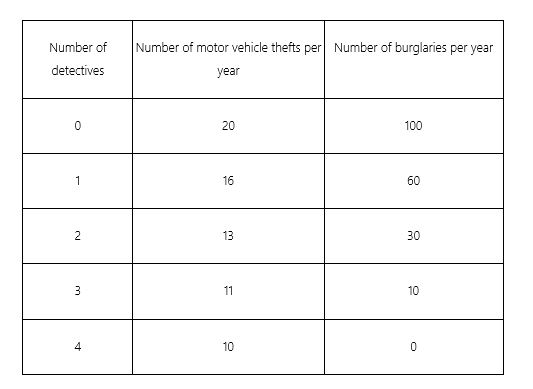Consider a police department trying to decide how to allocate its crime prevention resources between motor vehicle thefts and burglaries. The marginal benefit of one less motor vehicle theft is $20,000, and the marginal benefit of one less burglary is $1,000. Suppose the annual number of motor vehicle thefts and the annual number of burglaries depends on the number of detectives assigned to each type of crime, as shown in the table below. Each detective costs $35,000 each per year, regardless of whether the detective is assigned to motor vehicle thefts or burglaries.  What is the socially optimal number of detectives to be assigned to each type of crime?
What is the socially optimal number of detectives to be assigned to each type of crime?
A) 4 detectives to motor vehicle theft and 0 to burglary.
B) 3 detectives to motor vehicle theft and 1 to burglary.
C) 4 detectives to motor vehicle theft and 2 to burglary.
D) 0 detectives to motor vehicle theft and 4 to burglary.
Correct Answer:
Verified
Q112: The optimal amount of crime control occurs
Q113: The system of government insurance that pays
Q114: A rational public health policy would expand
Q115: Private markets would lead to a _
Q116: School districts in which relatively more parents
Q118: The graph below illustrates the marginal cost,
Q119: According to the textbook, as it is
Q120: Suppose that firms that had high rates
Q121: It is socially optimal to hire an
Q122: The figure below shows the marginal benefit
Unlock this Answer For Free Now!
View this answer and more for free by performing one of the following actions

Scan the QR code to install the App and get 2 free unlocks

Unlock quizzes for free by uploading documents